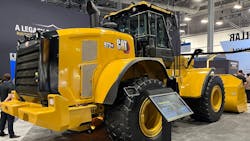Caterpillar Chases Sustainability with Efficiency
At the 2025 Consumer Electronics Show in January, Caterpillar exhibited a demonstration 972 XE front-end loader retrofit with a hybrid powertrain. At construction machinery and mining trade fair bauma 2025, held this April in Munich, Caterpillar further showcased its “The Next 100 Years” campaign promoting sustainability efforts by displaying industrial engines compatible with hydrotreated vegetable oils (HVOs).
Ditching fossil fuels and the pollution they belch into the air may sound more important in the long term for sustainability, but adopting HVOs might be a fantasy in the long run. Hybridizing engines, on the other hand, while much less sexy tech-wise, provides real benefits here and now.
Rob Hoenes, head of the electrification and energy solutions division at Caterpillar, says neither example is as important as increasing the efficiency of the engines that burn whatever sort of fuel we pump into their tanks.
We spoke with Hoenes about how Caterpillar plans to tackle sustainability in the long term, the organizational and supply chain adjustments required to pursue the effort and how to target the most appropriate investments. This interview is edited for clarity and length.
Sourcing for Sustainability
Dennis Scimeca: Looking at the 972XE hybrid powertrain demo at CES, I found myself wondering to what degree Caterpillar must add new manufacturing capacity to support development of those technologies. Is it just a matter of relationships with new OEMs to procure the different components those technologies might require? Or is Caterpillar better off creating its own manufacturing capacity, to better control supply?
Rob Hoenes: That machine we bought back from a dealer and you’re really looking at a retrofit solution. … Being able to source a majority of the content from the existing population and leveraging our own dealer network, our own remanufacturing capabilities, is probably one of the most elegant dimensions of your question about sourcing.
There are some components in [the 972XE] that are certainly new, like the battery, but the electric drive train, the power electronics, we’ve been doing that for [decades] in prime products and even longer when you look at the energy and transportation division that’s been around forever. A lot of people don’t realize that’s actually Caterpillar’s biggest division. We get a lot of credit for the machines, but it’s our energy and transportation division that’s the largest of the three verticals in the organization.
DS: How do you handle procuring battery technology?
RH: We are making substantial investments in cell manufacturing itself. We’re choosing to leverage partnerships with specific customers. Probably the thing that’s a little unique to us is our integration with the mining industry. We also are setting up offtake agreements with some of the more critical elements that can come into battery manufacturing.
You can see in the future that the circular economies that will involve not just our relationships in the mining industry, but also the dealer network and the remanufacturing capability become really critical to us in the design of any kind of an electrified product strategy.
Practical Engineering Beats All
DS: You’ve got your immediate customer demand that drives immediate R&D, like the hybrid powertrain and other electric technologies, and then there’s the long game, like biofuels and hydrogen. They might not be in huge demand right now, but that could change in a few decades. Does it make sense to get ahead on those future markets and if so, how do you decide which resources to throw at the question?
RH: Our biggest investments right now are getting the existing engines more efficient. That is the biggest thing we can do from a sustainability standpoint, especially when you consider the existing population of machines out there, and the possibility to bring those more efficient engines directly into the existing field population.
The next priority of investment is the alternative fuels, biofuels, hydrogen, methane…a list of fuels that are more affordable and more sustainable that engines are becoming capable of burning. That also takes some pretty substantial investment to [accomplish]. Not as much as the overall efficiency improvements, but shortly behind it. After that, you start to move out to a system integration level. That’s probably where we’re putting in the next effort with things like electric drive train.
There’s some advantage, before you even talk about a battery or being able to install electric motors [if] you can run that engine in its sweet spot, its most efficient range of operation and you can absorb the variation in demand in the electrical drive train. That has proven really successful for us over the last 20 years. And that’s probably the third area where we’re prioritizing long-term.
These first three things aren’t really in the electrification division. Most of those research priorities are being established in the business with direct requests from customers for those kind of improvements.
Then you think, "But there are some new technologies [and] customers don’t know what they don’t know,.” They’re not deep into how you make these industrial power systems more efficient. That’s the area where our division comes in and starts to spend a lot of time with the universities [and] with the different suppliers and investigating how new technologies might be applied. … It’s only when you get to the really uncertain stuff that I think you start to need divisions and dedicated, small teams looking at some of the faster moving technology.
Fleets Can't Stop to Modernize
DS: So the immediate plan is to hybridize existing engines out of a customer’s fleet.
RH: When you move to the hybrid like the 972XE, that’s pure concept right now. That’s what our division really does. But yes, the proposal you saw with that machine started with an existing product and saying, "Let’s take something that’s already out there and make a hybrid out of it." … When you do a machine rebuild, you can update the engine to the latest technology at the major rebuild interval, and there will be three, four, or five rebuilds on a particular machine.
DS: So who’s making those adjustments? Dealers? Caterpillar?
RH: It ends up being a combination. We’ve got a really broad line of remanufactured engines, so it may not be the dealer doing the engine rebuild. They may be sourcing a remanufactured engine.
We try to hit a predicted rebuild interval. Those intervals giving [customers] the opportunity to move to the latest technology is a big window for us to bring some of these energy solutions we’re talking about. In the case of the hybrid you saw, that is the strategy. Whether or not it tests out and customers [accept] the trade off…[when] you start putting a battery in an engine, now you’ve got some incremental cost, versus just putting the same old engine in there. But [the hybrid engine] comes with some incremental benefits. That’s where the economics really become the determinant on whether or not we see further uptake in these in these solutions.
DS: Hybridization becomes part of product lifecycle management.
RH: When you ask about what needs to be different with the supply chains, there’s a big chunk of it that doesn’t have to be totally different. Those will be the fastest adopted changes that come in a normal way, through a normal channel. That’s where we can make the most progress because it’s the easiest step change…and a lot of those ultimately end up back in the main part of the business.
DS: Is there a limit to what you can do by taking these natural rebuild opportunities to introduce new energy technologies? At some point you’re going to need to start designing new engines specifically with sustainability in mind, won’t you? How far can this rebuild program go before it’s time to start upgrading to entirely new engines?
RH: I’m sure there’s a philosophical or a hypothetical limit based on physics, but we’re a long way from it. There’s still a lot of opportunity to get more efficiency. You start moving into a whole range of technologies around thermal efficiency of internal combustion engines, and there’s still a lot of exciting new technologies coming in that we will ultimately bring to production.
About the Author
Dennis Scimeca
Dennis Scimeca is a veteran technology journalist with particular experience in vision system technology, machine learning/artificial intelligence, and augmented/mixed/virtual reality (XR), with bylines in consumer, developer, and B2B outlets.
At IndustryWeek, he covers the competitive advantages gained by manufacturers that deploy proven technologies. If you would like to share your story with IndustryWeek, please contact Dennis at [email protected].


